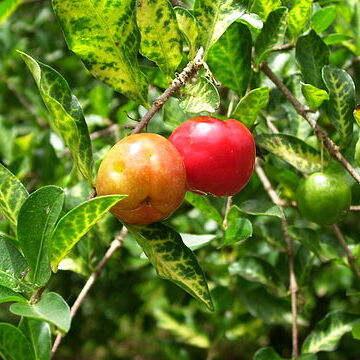lacerate-dentate all around, undulated or plaited, (2.5-)3-7(-9) mm diam., the lateral petals smaller than the posterior petal, 5-9 mm long, the claw obviously thinner, (1.5-)2-3 mm long, the limb suborbicular to ovate-deltoid, lacerate-den-tate all around or at least on the lower third, revolute or involute, not plicate or undulate, (2-)3-7(-8) mm diam., anterior petals usually smaller than the lateral petals, (4-)4.5-6.5(-8.5) mm long, the claw thin, (1-)1.5-3(-3.5) mm long, the limb ovate-deltoid to suborbicular, entire or sometimes lacerate-dentate at the base, revolute or involute, never plicate or undulate, (1.5-)2-5(-7) mm diam.; filaments 10, glabrous, 2-4 mm long, united at the base to form a short tube (0.5-)1(-1.5) mm long, all filiform and straight except sometimes those opposite the lateral petals, those opposite the sepals 0.5-1.0 mm longer than those opposite the anterior and posterior petals, anthers suborbicular to ovate, 0.5-1.5 mm long, pollination gap (distance between anthers and stigmas) 0-1 mm, the connective yellow, verrucose, suborbicular to ovate; styles 3, (straight, equal in thickness and length, diverging at acute angles from each other or the lateral styles thicker and longer than the anterior, straight or curved inwards) glabrous, free, (1.5-)2-4.5 mm long, obtuse, truncate or uncinate at apex, never subulate, the stigmatic surface on the inner angle of the apex, the ovary superior, glabrous, 3-locular, syncarpous subglobose, lobed or unlobed, 1.5-2 mm diam., ovules 1 per locule, pendulous, receptacle flat or nearly so; fruit 3-seeded, red, glabrous, the fleshy drupe up to 3 cm diam., pyramidato-globose or subglobose and flattened at poles, pyrenes ovoid, united, (oblong and separating at maturity in M. albiflora) to 1.8 cm long, winged dorsally and laterally, intermediate wings present or the surface pitted, tuberculate or rarely smooth; seeds with embryo curved, cotyledons fold-ed at apex, endosperm none.
Shrubs or small trees. Leaves usually bearing (0–)2–4[–10] glands impressed in abaxial surface of blade; stipules interpetiolar, mostly distinct. Inflorescences axillary, dense corymbs or umbels. Pedicels raised on peduncles. Flowers all chasmogamous, 6+ mm diam., showy with visible petals, stamens, and styles; calyx glands 6(–10) (3 sepals each bearing 2 large glands, others very rarely bearing 1–4 smaller glands); corollas bilaterally symmetric, petals pink, lavender, or white, glabrous [glabrate]; stamens 10, all fertile; anthers subequal or 2 opposite posterior-lateral petals larger; pistil 3-carpellate, carpels completely [rarely proximally] connate in ovary; styles 3, cylindric, stout; stigmas on internal angle or subterminal, large. Fruits drupes [berries or very rarely breaking into separate pyrenes], red [sometimes orange]; pyrenes 3, connate in center or distinct at maturity but then usually retained in common exocarp, walls hard, bearing rudimentary dorsal and lateral wings and sometimes rudimentary intermediate winglets or dissected outgrowths. x = 10.
Small trees or dwarf shrubs. Leaves shortly petioled, with small, narrow stipules, glandless, sometimes thorny-dentate. Flowers solitary or in inflorescences, bisexual, zygomorphic. Calycinal glands distinct, up to 2 at the base of each sepal, 6 being always present in the posterior part, 1-4 incidentally present in the anterior part of the calyx. Petals inequal, fimbriate (the larger ones) to entire (the smaller ones), distinctly clawed, glabrous. Stamens glabrous, shorter than the petals, 2 opposite ones in the transversal plane different from the other 8. Ovary glabrous; styles free, diverging, as a rule 2 well developed, the posterior one abortive. Fruit fleshy, separating into drupe-like nuts.

